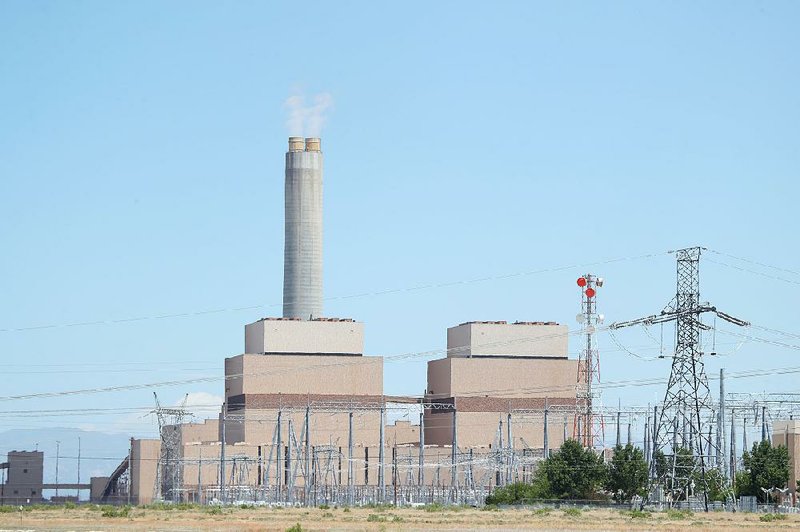America's coal-burning power plants are shutting down at a rapid pace, forcing electric utilities to face a decision: Embrace natural gas, or shift aggressively to renewable energy?
Some large utilities, including Xcel Energy in the Upper Midwest, are now planning to sharply cut their coal and gas use in favor of clean and abundant wind and solar power, which have steadily fallen in cost. But in the Southeast and other regions, natural gas continues to dominate, because of its reliability and low prices driven by the fracking boom. Nationwide, energy companies plan to add at least 150 gas plants and thousands of miles of pipelines in the years ahead.
A rush to build gas-fired plants, even though they emit only half as much carbon pollution as coal, has the potential to lock in decades of new fossil-fuel use right as scientists say emissions need to fall drastically by midcentury to avert the worst impacts of global warming.
"Gas infrastructure that's built today is going to be with us for 30 years," said Daniel Cohan, an associate professor of civil and environmental engineering at Rice University.
"But if you look at scenarios that take climate change seriously, that say we need to get to net zero emissions by 2050," he said, "that's not going to be compatible with gas plants that don't capture their carbon."
In some states, policymakers are now pushing to leave gas behind to meet ambitious climate goals. Last week, New York lawmakers passed a sweeping energy bill that calls for the state to switch to entirely carbon-free electricity sources by 2040, following states like California and New Mexico that have passed similar laws.
Since 2005, most power companies have reduced their carbon dioxide emissions significantly, in large part by shifting from coal to gas. Coal plants have become uncompetitive with other kinds of energy generation in much of the country, despite President Donald Trump's administration's efforts to save them by rolling back federal pollution regulations.
But in a recent analysis, David Pomerantz, the executive director of the Energy and Policy Institute, a pro-renewables group, looked at the long-term plans of the 22 biggest investor-owned utilities. Some in the Midwest are planning to speed up the rate at which they cut emissions between now and 2030. But other large utilities, like Duke Energy and American Electric Power, expect to reduce their carbon emissions at a slower pace over the next decade than they had over the previous decade.
"I really think gas is at the crux of it," Pomerantz said. "You've got some utilities looking at gas and saying, 'No thanks, we think there's a cleaner and cheaper path.' But then you've got others going all in on gas."
Last fall, in North and South Carolina, a pair of utilities owned by Duke Energy filed plans with state regulators to continue retiring coal plants and largely replace them with more than 9,500 megawatts of new natural gas capacity by 2033. The utilities also plan to add a smaller amount of solar capacity, about 3,600 megawatts, over the same time frame.
"Right now, gas is still the most cost-effective option for us," said Kenneth Jennings, Duke's director of renewable strategy and policy.
One challenge with using more solar power, he noted, is finding a way to supply electricity when the sun isn't shining. Although Duke is installing some large lithium-ion batteries to store solar energy for less-sunny hours, the company says batteries still haven't reached the point where they're as cheap or effective as gas power, which can run at all hours.
Jennings also said that it can be tough to add wind power in the Carolinas, where the terrain is less favorable than the wide-open Midwest and lawmakers have limited the construction of new turbines on mountain ridges and near military bases along the coast.
Opponents of Duke's plans, including environmental groups and local renewable energy producers, have urged state regulators to push the utility to reconsider. They have sharply disputed Duke's analysis, arguing that the utility is downplaying the potential for solar, wind and batteries.
A similar fight is unfolding in Florida, where the local Sierra Club is challenging a proposal by Tampa Electric to replace two older coal units with a large new natural gas plant. The Sierra Club's pitch to the governor, who still has to approve the plan: Florida can't afford to deepen its reliance on gas at a time when climate change and sea level rise are threatening the state's coast.
For Tampa Electric, the choice is complex. The utility plans to get 7% of its power from solar by 2021, but says that until storage technologies improve, gas will form the backbone of its energy mix as it tries to meet energy needs in a fast-growing part of the state.
These disputes are popping up in states around the country. Over the past decade, groups like the Sierra Club have tried to persuade utilities and regulators that they could save money by retiring coal and shifting to a cleaner mix of gas and renewables. Now they're running the same playbook against gas, arguing that the costs of wind, solar and batteries have declined so drastically that it's time to stop building new gas plants, too.
So far, results have been mixed: Regulators in Arizona and Indiana have recently blocked plans for new gas plants, agreeing with opponents that utilities hadn't fully considered alternatives and that large new gas projects could be a risky bet at a time when clean energy technology is improving fast.
But last year in Michigan, regulators approved DTE Energy's plan to build a new $1 billion gas plant, rejecting analyses by outside groups that the utility could save ratepayers money by scrapping the plant and making greater use of wind, solar and energy efficiency.
Business on 06/29/2019
